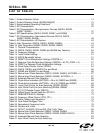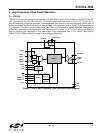
Si53xx-RM
Rev. 0.5 13
A wide range of settings are available, but they are a subset of the frequency plans supported by the Si5323 and
Si5366 jitter-attenuating clock multipliers. The Si5325 and Si5367 are microprocessor-controlled clock multipliers
that can be controlled via an I
2
C or SPI interface.
These devices accept clock inputs ranging from 10 MHz to 710 MHz and generate multiple independent,
synchronous clock outputs ranging from 10 MHz to 945 MHz and select frequencies to 1.4 GHz. The Si5325 and
Si5367 support a subset of the frequency translations available in the Si5319, Si5324, Si5326, Si5327, Si5368, and
Si5369 jitter-attenuating clock multipliers. The Si5325 and Si5367 can accept input clocks at different frequencies
and generate output clocks at different frequencies. The Si5322, Si5325, Si5365, and Si5367 support a digitally
programmable loop bandwidth that ranges from 150 kHz to 1.3 MHz. No external components are required for
these devices. LOS and FOS monitoring is available for these devices, as described above.
The Si5374 and Si5375 are quad DSPLL versions of the Si5324 and Si5319, respectively. Each of the four
DSPLLs can operate at completely independent frequencies. The only resources that they share are a common
I
2
C bus and a common XA/XB jitter reference oscillator. The Si5375 consists of four one-input and one-output
DSPLLs. The Si5374 consists of four two-input and two-output DSPLLs with very low loop bandwidth.
The Any-Frequency Precision Clocks have differential clock output(s) with programmable signal formats to support
LVPECL, LVDS, CML, and CMOS loads. If the CMOS signal format is selected, each differential output buffer
generates two in-phase CMOS clocks at the same frequency. For system-level debugging, a PLL bypass mode
drives the clock output directly from the selected input clock, bypassing the internal PLL.
Silicon Laboratories offers a PC-based software utility, DSPLLsim, that can be used to determine valid frequency
plans and loop bandwidth settings for the Any-Frequency Precision Clock product family. For the microprocessor-
controlled devices, DSPLLsim provides the optimum PLL divider settings for a given input frequency/clock
multiplication ratio combination that minimizes phase noise and power consumption. Two DSPLLsim configuration
software applications are available for the 1-PLL and 4-PLL devices, respectively. DSPLLsim can also be used to
simplify device selection and configuration. This utility can be downloaded from http://www.silabs.com/timing.
Other useful documentation, including device data sheets and programming files for the microprocessor-controlled
devices are available from this website.


















